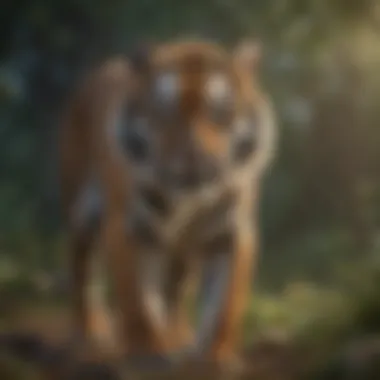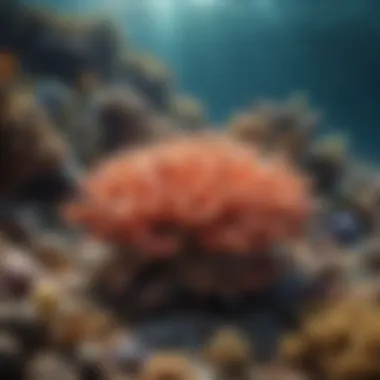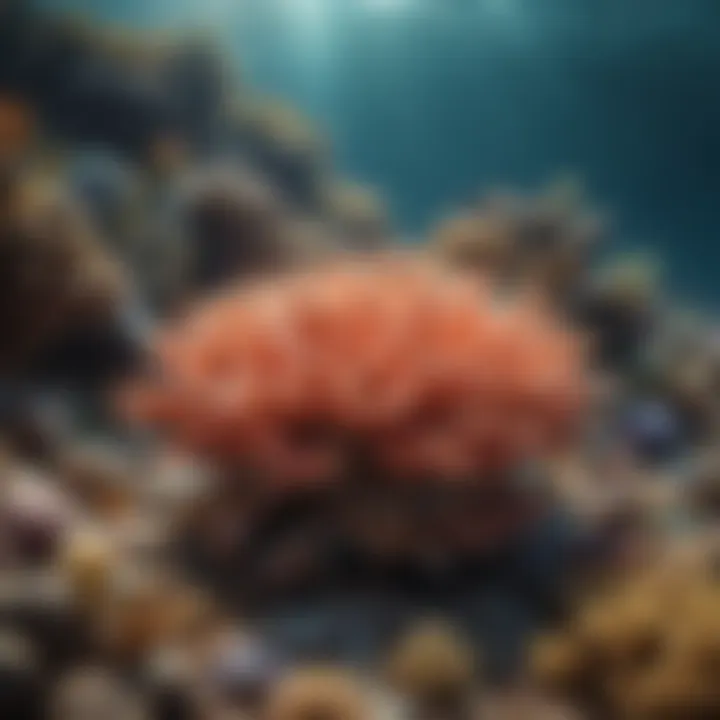Exploring Endangered Species and Their Conservation


Overview of the Topic
Understanding endangered species is crucial for preserving biodiversity and maintaining ecosystem integrity. Each species plays a unique role within its habitat, contributing to the health of natural environments. With the increasing threats of habitat destruction, climate change, and poaching, a significant number of species face the risk of extinction. This article explores various facetes of endangered species, shedding light on their importance and the dire consequences of their decline.
Background Information
The term "endangered species" refers to species at risk of extinction due to environmental and anthropogenic factors. These species are often indicators of the health of their ecosystems. Therefore, monitoring their status can reveal the broader impacts of human activity on the environment. For many species, the struggle for survival is exacerbated by loss of habitat from urbanization, industrialization, and deforestation. In addition, invasive species pose a threat by disrupting local ecosystems.
Current Status and Challenges
A wide range of species now find themselves listed as endangered. According to the International Union for Conservation of Nature (IUCN), over 40,000 species are currently known to be threatened. This alarming figure is reflective of environmental degradation and loss of biodiversity.
Examination of the Current State
Habitats such as tropical rainforests, wetlands, and oceans experience the highest rate of biodiversity loss. Species such as the Javan rhinoceros and Amur leopard exemplify this crisis. Both are critically endangered, fighting against shrinking territories and human interference. Monitoring international and local laws shows that, despite existing efforts to protect these species, many still struggle toward recovery.
Identification of Challenges
Several obstacles hinder conservation efforts:
- Habitat Destruction: Urban expansion and agricultural development lead to the fragmentation of ecosystems, isolating species.
- Pollution: Chemicals and waste products poison habitats, severely impacting wildlife.
- Climate Change: Changing weather patterns and rising sea levels shift habitats and endanger species.
- Illegal Wildlife Trade: Poaching remains a serious issue for many species, particularly in regions where economic benefits outweigh legal protections.
Sustainable Solutions
Despite the grim scenario, various strategies exist to mitigate the impact on endangered species. Conservation measures focus on habitat preservation and international cooperation.
Exploration of Sustainable Practices
- Protected Areas: Establishing national parks and wildlife reserves can provide safe havens for endangered species to thrive without human disturbance.
- Community Engagement: Involving local populations in conservation efforts fosters awareness and a sense of stewardship over their natural resources.
- Legislation: Enforcing existing international treaties, such as CITES, is essential to combat illegal trade and protect threatened species.
Successful Case Studies
Projects like the recovery efforts for the California condor showcase effective management strategies. Through captive breeding and habitat protection, the population of this bird has shown significant improvement over the past decades. Similarly, the red wolf recovery program highlights how focused initiatives can help restore populations previously decimated.
Impact and Importance
The decline of endangered species carries wide-ranging implications for ecosystems and humanity itself. Biodiversity fosters resilience among ecological communities, enabling them to withstand environmental changes and stresses.
Analysis of the Impact
The loss of a species can disrupt food chains and lead to unforeseen consequences. When apex predators, such as wolves, diminish, herbivore populations can surge, leading to overgrazing and vegetation loss. Such scenarios highlight the intricate balance within ecosystems.
Emphasis on Conservation
Conservation efforts preserve not only the species themselves but also the ecosystems they inhabit. Protecting diverse forms of wildlife ensures that future generations inherit a planet rich in biodiversity.
"The extinction of a species is not merely a loss of life; it can alter the fabric of our ecosystems irreparably."
Understanding Endangered Species
Understanding the concept of endangered species is essential in today’s context of environmental preservation. This section seeks to unravel vital elements that contribute to the comprehension of endangered species and why they matter. It allows readers to appreciate the delicate balance of ecosystems and the implications of losing specific species. The overarching goal is to foster a deeper sense of urgency and responsibility towards wildlife preservation.
Definition of Endangered Species
An endangered species is a population of organisms that faces a high risk of extinction in the near future. This classification can be based on various factors, including population size, habitat loss, and degree of threat from human activities. Recognizing a species as endangered is a formal acknowledgment of its precarious state.
In many cases, governmental and non-governmental organizations use distinct criteria to determine this status. Species such as the Amur Leopard and the Vaquita are examples that highlight the reality of endangerment. Understanding the definition is not just an academic exercise; it is crucial for mobilizing conservation efforts.
Importance of Biodiversity
Biodiversity serves as a cornerstone of ecological health. It encompasses the variety of living organisms, from plants to animals, and their interactions within ecosystems. The importance of biodiversity cannot be overstated; it provides essential services that sustain life, including food, clean air, and water. Loss of biodiversity can lead to diminished ecosystem resilience, making it less adaptable to changes or stressors, such as climate change.
Moreover, every species plays a unique role. The decline or extinction of a single species can have cascading effects on other organisms and the environment. It is vital for conservationists, students, and environmentalists to understand how interconnected these relationships are. It provides a clearer understanding of why protecting endangered species is not just about saving individual animals but also about maintaining the integrity of entire ecosystems.
Criteria for Endangerment
The criteria for determining the status of a species as endangered vary across different organizations. However, some key factors remain consistent. These typically include:
- Population Size: A small population is often more vulnerable to extinction due to reduced genetic diversity.
- Rate of Decline: Rapid decreases in population numbers can trigger an endangered status.
- Geographic Range: Limited distribution can make species more susceptible to extinction.
- Threats: Human-induced threats such as habitat destruction, pollution, and poaching can elevate species to endangered status.
Understanding these criteria helps in assessing conservation needs and demarcating appropriate actions. It equips stakeholders with the insights necessary to implement effective protection measures.
"Conservation is a state of harmony between men and land." – Aldo Leopold


Factors Contributing to Endangerment
Understanding the factors that contribute to the endangerment of species is crucial for developing effective conservation strategies. The threats these species face can be complex and intertwined, impacting various ecosystems. By comprehensively examining these factors, we can identify targeted interventions that address the root causes of decline and foster a sustainable environment for all species.
Habitat Loss
Habitat loss is one of the primary drivers behind species endangerment. As human populations grow, land is increasingly converted for agriculture, urban development, and industrial use. This results in the destruction and fragmentation of natural habitats, making it difficult for species to thrive. Different animals may require specific habitats for nesting, feeding, or breeding. When these environments are lost, biodiversity declines, and some species face extinction.
The impact of habitat loss is significant. For example, deforestation in rainforests not only affects the flora and fauna within that specific region but also contributes to climate change. The removal of trees disrupts the balance of carbon dioxide in the atmosphere. Moreover, fragmented habitats leave species isolated, reducing genetic diversity and their ability to adapt to changing environmental conditions. Conservation efforts must prioritize habitat preservation to mitigate these risks.
Climate Change
Climate change poses an existential threat to many species around the world. Rising temperatures, changing precipitation patterns, and increased frequency of extreme weather events shift the ecosystems that species rely on. Animals that cannot adapt to rapid climate changes may face extinction.
For instance, polar bears rely on sea ice for hunting seals. As temperatures rise, sea ice melts, reducing their hunting grounds. Similarly, many plant species face challenges in maintaining their ecosystems. Changes in climate can also lead to mismatches in timing between species, such as pollinators and the flowering of plants. This disconnect can lead to declines in animal populations and ultimately affect entire ecosystems.
Efforts to address climate change through reducing greenhouse gas emissions are essential, but also require strategies for protecting vulnerable species and their habitats.
Poaching and Illegal Trade
Poaching and illegal trade is a significant contributor to the endangerment of various species. Many animals are hunted for their parts, including ivory, fur, and bones, while others are captured live for the exotic pet trade. This illicit activity not only threatens individual species but also disrupts ecosystem balances.
For instance, the demand for rhino horns has led to a dramatic decline in rhino populations. Similar situations are seen with tigers, whose body parts are used in traditional medicine. Regulatory measures, such as strengthened laws and improved enforcement, are crucial in combating poaching. However, community engagement is equally important, as providing alternative livelihoods can reduce reliance on illegal activities.
Pollution
Pollution is another critical factor driving species toward endangerment. Contaminants in the air, water, and soil can have dire effects on wildlife health. Chemicals like pesticides disrupt hormonal systems in animals, affecting reproduction and development. Moreover, plastic pollution endangers marine life, as many species ingest or become entangled in waste, leading to injury or death.
For example, freshwater bodies polluted with heavy metals and industrial waste lead to a decline in fish populations. The repercussions of pollution extend through entire food webs, affecting predator species as well. Reducing pollution through stricter regulations, better waste management practices, and public awareness is vital for protecting vulnerable species.
"Conserving biodiversity hinges on our understanding of these multifaceted threats. The risk to one species can have cascading effects throughout entire ecosystems."
By recognizing these factors contributing to endangerment, we can develop targeted conservation strategies that address not only the symptoms but the underlying causes of species decline. This is essential for sustaining biodiversity and preserving the ecological health of our planet.
Highlighted Endangered Species
The examination of highlighted endangered species serves multiple purposes in understanding conservation efforts. By focusing on specific animals, we can illustrate the broader issues surrounding threats to biodiversity, habitat loss, and the impact of human activity. Each species represents a unique set of challenges and recovery efforts, showcasing the interconnectedness of ecosystems and the ripple effects that losing one species can have on others.
Amur Leopard
Physical Characteristics
The Amur leopard is distinct in its exquisite coat, characterized by thick fur spotted with black rosettes. This adaptation helps it blend into its environment, providing crucial camouflage in the snowy habitats it calls home. The significance of these physical traits lies not only in survival but also in attracting conservation attention. The striking appearance of the leopard generates interest and awareness, making it a valuable ambassador for the cause of endangered species.
Habitat and Range
Amur leopards primarily inhabit the temperate forests of the Russian Far East. Their range is limited, as these leopards occupy a specific ecological niche. This narrowed habitat brings attention to the fragility of their environment. Highlighting their range emphasizes the urgent need for conservation in this area, as any changes in land use can have dire consequences for their survival.
Conservation Efforts
Conservation efforts for the Amur leopard include habitat protection, anti-poaching measures, and the establishment of protected areas. Noteworthy is the Land of the Leopard National Park in Russia, which plays a crucial role in their survival. By illustrating these efforts, the article underscores the importance of collaborative conservation strategies, fostering hope that targeted actions can lead to recovery.
Sumatran Orangutan
Behavioral Adaptations
The Sumatran orangutan exhibits remarkable behavioral adaptations that facilitate its survival in the rainforests of Sumatra. These include tool use for foraging and intricate social structures. Such traits are essential for understanding the species' ecological role and the influence it has on its environment. The intelligence displayed by these orangutans makes them an engaging subject for conservation and educational efforts.
Threats to Survival
The Sumatran orangutan faces significant threats from deforestation and illegal hunting. These threats not only jeopardize their population but also disrupt the entire forest ecosystem. By focusing on these threats, the article highlights the pressing need for immediate action to protect not just Individual species, but the broader ecosystem they support.
Role in Ecosystem
Sumatran orangutans play a critical role in maintaining the health of their forest habitat. Their feeding habits promote seed dispersal, helping to sustain plant diversity. This interconnectedness illustrates how the plight of the orangutan affects numerous other species. Emphasizing their ecological role adds depth to conservation discussions, urging greater efforts for habitat preservation.
Javan Rhinoceros
Population Status
The Javan rhino is one of the world’s rarest large mammals, with a population of fewer than 80 individuals remaining in Ujung Kulon National Park, Indonesia. This dire population status underscores the urgency for conservation measures. The minimal number of surviving rhinos highlights issues related to genetic diversity and the risk of extinction.


Conservation Challenges
Conservation challenges for the Javan rhinoceros primarily include habitat loss and poaching. The limited range of this rhino complicates conservation efforts, as any environmental disturbance can have catastrophic effects. By highlighting these challenges, the article can stress the need for robust protective measures ensuring the rhino's continued existence.
Current Protection Measures
Current protection measures include active monitoring of populations and habitat management within Ujung Kulon National Park. International cooperation plays a crucial role, as organizations work together to bolster protection efforts. Detailing these measures allows us to understand what is being done and the gaps that still need to be filled to ensure a viable future for this species.
Vaquita
Critical Condition
The Vaquita is critically endangered, with fewer than 30 individuals estimated to remain in the Gulf of California. Its situation is an urgent call to action for conservationists. Understanding the critical condition of the Vaquita emphasizes the dire need for immediate intervention to halt its decline.
Impact of Fishing Practices
Illegal fishing practices pose the most significant threat to the Vaquita's survival. These fishing methods inadvertently catch Vaquitas in gillnets, leading to their drowning. Focusing on the impacts of these practices is crucial for raising awareness and advocating for better fishing regulations and practices that can prevent the extinction of this marine mammal.
International Response
The international community has increasingly responded to the Vaquita's plight through advocacy and proposed sanctions on illegal fishing. However, the effectiveness of these measures remains a point of debate. Highlighting international response efforts includes discussing both successes and difficulties, reflecting on the importance of collective global responsibility in conservation efforts.
Snow Leopard
Habitat Description
Snow leopards inhabit the mountainous regions of Central and South Asia, where their thick fur and long tail are adaptations to cold climates and steep terrains. The specificity of their habitat needs makes them particularly vulnerable to climate change and habitat fragmentation. Understanding their habitat requirements informs effective conservation strategies to preserve these majestic cats.
Stewardship Programs
Stewardship programs for snow leopards involve local communities in conservation efforts. By fostering awareness and support for snow leopard preservation, these programs create local incentives for protecting wildlife. Highlighting these initiatives shows a promising way forward in building sustainable relationships between communities and conservation goals.
Community Involvement
Community involvement is vital for the success of snow leopard conservation. Local awareness programs educate populations about the importance of biodiversity. Engaging communities fosters a sense of responsibility toward their natural environment. By spotlighting community efforts, the article shows how grassroots involvement contributes significantly to protecting endangered species, benefitting both wildlife and local livelihoods.
Global Conservation Efforts
Global conservation efforts are crucial for the protection of endangered species around the world. They encompass a vast range of strategies and actions undertaken by various stakeholders, including governments, non-governmental organizations (NGOs), and local communities. The effectiveness of these efforts is particularly significant because they aim to combat the wide array of threats that impact wildlife populations and their habitats. Sustainable conservation practices not only help to preserve species at risk but also maintain the delicate balance of ecosystems. This section examines key components within global conservation efforts, emphasizing the roles of international treaties, protected areas, and community engagement.
International Treaties
CITES
The Convention on International Trade in Endangered Species of Wild Fauna and Flora, commonly known as CITES, is a pivotal agreement aimed at ensuring that international trade does not threaten the survival of wildlife. CITES works by regulating and monitoring international trade in specific species through a system of permits. A key characteristic of CITES is its focus on species' conservation rather than habitat preservation. The treaty has seen success in protecting species like elephants and rhinos from poaching due to illegal ivory trade. One unique feature of CITES is its appendices, classifying species into different levels of threat, which helps in prioritizing conservation actions. Despite its merits, CITES has limitations, including compliance challenges among member states. It requires ongoing collaboration and commitment from all parties to be truly effective.
Convention on Biological Diversity
The Convention on Biological Diversity, often abbreviated as CBD, is a global treaty that addresses all aspects of biological diversity – one of the key pillars of sustainable development. The CBD aims to promote sustainable use of biological resources and the fair sharing of benefits derived from genetic resources. A significant aspect of this convention is its emphasis on national implementation, encouraging countries to set specific conservation goals tailored to their unique biodiversity. The CBD is recognized as a beneficial framework because it aligns local and global conservation efforts. A unique characteristic of the CBD is its strategy on integrating biodiversity into various sectors, like agriculture and forestry. However, the challenge remains in ensuring that countries meet their commitments, with progress sometimes being sluggish.
Protected Areas and Reserves
National Parks
National parks play an essential role in global conservation efforts by providing protected areas where ecosystems can thrive without human interference. They serve as critical habitats for many endangered species, safeguarding them from habitat loss and other threats. The key characteristic of national parks is that they are legally protected areas, established to preserve significant natural and cultural resources. Their popularity arises from their dual function—they not only conserve biodiversity but also offer recreational opportunities for the public. A unique feature of national parks is their capacity to act as biodiversity hotspots, supporting diverse flora and fauna. However, the establishment of national parks can sometimes lead to conflicts with local communities, particularly regarding land use.
Wildlife Sanctuaries
Wildlife sanctuaries provide safe havens for endangered species, often focusing on rehabilitation and recovery efforts. Unlike national parks, wildlife sanctuaries can provide more managed environments where human-animal interactions are controlled. The crucial aspect of wildlife sanctuaries is their ability to offer long-term protection for individual animals that cannot survive in the wild. They also contribute to education and awareness about conservation. A unique feature is the emphasis on active recovery programs for specific species. However, they can face challenges such as funding and perceptions of captivity versus wildness, raising debates about the best ways to protect species.
Community-Based Conservation
Local Engagement
Local engagement is a cornerstone of effective conservation strategies. It involves communities in decision-making, ensuring that local knowledge and priorities are integrated into conservation practices. One key aspect of local engagement is its potential to foster a sense of ownership over natural resources among community members. This strategy often results in better compliance with conservation measures because locals generally wish to protect their environment. The unique feature of this approach is that it can lead to innovative, locally-adapted solutions to conservation challenges. However, ensuring that all community voices are heard can be a challenge, particularly in diverse populations where interests may conflict.
Sustainable Practices
Sustainable practices are vital in conservation as they seek to minimize human impact while allowing for responsible resource use. This includes aspects such as sustainable agriculture, eco-tourism, and responsible fishing. A key characteristic of sustainable practices is their focus on long-term benefits for both biodiversity and human communities. They are increasingly recognized as beneficial because they promote economic development without compromising ecological health. The unique feature is the balance they aim to achieve between conservation and livelihood needs. Nonetheless, the implementation of sustainable practices requires robust education and support systems to ensure their successful uptake in communities.
Role of Technology in Conservation


The role of technology in conservation has become increasingly significant in recent years. As the planet faces various environmental challenges, innovative approaches using technological advancements provide essential tools for protecting endangered species. This section explores how technology enhances conservation efforts, focusing on remote sensing, genetic conservation techniques, and data analytics for wildlife monitoring. By leveraging these methods, conservationists can improve their strategies and implement more effective measures.
Remote Sensing
Remote sensing involves the use of satellite or aerial imagery to collect information about the Earth's surface without needing physical presence. This technology plays a crucial part in conservation by enabling researchers and organizations to monitor habitats, track land-use changes, and assess ecosystem health. The benefits of remote sensing include:
- Large-scale Monitoring: It allows the analysis of vast regions efficiently, which is essential for tracking environmental changes over time.
- Mapping Habitats: Remote sensing helps in creating detailed maps that show the distribution of different species and their habitats.
- Climate Change Impact Assessment: By observing vegetation patterns and land cover changes, scientists can evaluate how climate change impacts ecosystems.
Moreover, remote sensing can inform various conservation initiatives by identifying areas needed for protection or restoration. As technology improves, the accuracy and functionality of remote sensing continue to advance, making it an invaluable resource for conservationists.
Genetic Conservation Techniques
Genetic conservation techniques are vital for maintaining the genetic diversity of endangered species. These methods ensure that populations remain healthy and can adapt to changing environmental conditions. Key aspects of genetic conservation techniques include:
- DNA Analysis: Scientists utilize DNA analysis to understand the genetic health of species. This analysis can identify inbreeding and inform breeding programs to enhance genetic diversity.
- Cryopreservation: This technique involves freezing genetic material, such as sperm and eggs, to preserve endangered species for future breeding efforts.
- Cloning and Artificial Insemination: Innovative reproductive technologies, such as cloning or artificial insemination, can aid endangered species in reproduction.
Overall, the integration of genetic techniques not only helps in protecting species from extinction but also plays a role in maintaining ecosystems' resilience.
Data Analytics for Wildlife Monitoring
Data analytics is transforming how wildlife is monitored and managed. With the rapid growth of data collection methods, such as camera traps and GPS tracking, conservationists can access large volumes of information. This facilitates better decision-making and more strategic conservation management. Noteworthy points in this area include:
- Behavioral Analysis: Analytics can reveal patterns in animal behavior and movement, providing insights into habitat usage and population dynamics.
- Trend Identification: By processing historical data, analysts can identify trends in species populations, offering valuable information on the effectiveness of conservation measures.
- Real-time Monitoring: Advanced data analytics enable real-time monitoring of wildlife, allowing conservationists to respond quickly to threats, such as poaching or habitat destruction.
"Using data analytics not only enhances our understanding of wildlife but also empowers conservationists to act swiftly and effectively."
Public Awareness and Education
In the realm of conservation, public awareness and education serve as vital mechanisms that underpin the success of efforts to protect endangered species. Understanding the urgency of the crisis we face requires informed citizens who can advocate for change and make responsible choices in their daily lives. Edification increases ability to grasp complex environmental issues, leading to more engaged communities dedicated to stewardship and conservation of wildlife.
"An informed public is the cornerstone of effective conservation initiatives."
Role of NGOs
Non-Governmental Organizations play a fundamental role in raising public awareness about endangered species. Organizations like the World Wildlife Fund and Conservation International focus not only on direct conservation action but also on educating the public about the plight of various species. They run campaigns, workshops, and outreach programs that inform and mobilize local communities. Their efforts often involve collaborations with local schools and institutions to integrate conservation topics into the education system.
Moreover, NGOs frequently use advocacy to influence policy. They exploit their platforms to shed light on pressing issues such as habitat destruction and poaching, allowing concerned citizens to participate actively in advocacy efforts. Their resources often include reports and informational brochures that simplify complex data into actionable insights.
Educational Programs
Educational programs aimed at different demographics can wield significant influence. They can be tailored to children, adults, or specific professional groups. By incorporating interactive methods including field trips, hands-on conservation projects, and workshops, these programs facilitate a rich learning experience.
- School Programs: Engage young minds through hands-on activities that emphasize nature appreciation and conservation ethics.
- University Initiatives: Foster research and awareness projects, encouraging students to contribute to conservation science.
- Community Workshops: Provide practical knowledge on sustainable practices, empowering citizens in local conservation efforts.
The effectiveness of educational programs lies in their ability to evoke empathy and personal responsibility toward the environment. When people understand the personal and global stakes of species loss, they may feel compelled to act.
Media's Influence
Media plays a crucial role in shaping public perception and awareness regarding endangered species. Documentaries, news articles, social media campaigns, and television programs can highlight the stories of the species at risk and the pressing urgency behind conservation initiatives. Positive portrayals can inspire action, while stark images can provoke necessary discomfort that spurs the audience into engagement.
- Documentaries: Provide powerful visual portrayals that can emotionally connect viewers to otherwise distant wildlife issues.
- Social Media: Platforms like Facebook and Instagram excel at spreading awareness quickly. Their reach can mobilize grassroots support as people share posts across their networks.
- News Coverage: Timely coverage of conservation issues can pressure policymakers to act and keep the public informed about successful efforts and ongoing challenges.
In summary, the trio of NGOs, educational programs, and media collectively enhance public awareness and education around endangered species. Together, they foster a deeper understanding of the complexities involved in wildlife conservation, encouraging active participation in protecting our planet’s biodiversity.
Future Directions in Conservation
The landscape of conservation is in constant evolution. New challenges emerge, and technology advances, providing novel tools to address the ongoing crisis facing endangered species. Understanding these future directions is essential for conservationists, policymakers, and the global community. It highlights the shifting paradigms in conservation strategies while emphasizing the urgency needed to act on these insights. The direction conservation takes will determine the fate of countless species and the ecological balance that sustains life on Earth.
Innovative Approaches
Innovative approaches to conservation leverage cutting-edge science and technology to improve outcomes for endangered species. Techniques such as eDNA sampling allow researchers to gather genetic material from environmental samples, paving the way for more accurate monitoring of species presence and biodiversity. Conservation drones, equipped with cameras and sensors, can survey remote areas, aiding in habitat assessment and anti-poaching efforts.
Moreover, community-based conservation initiatives are gaining traction. Local people act as stewards of their environment, creating sustainable practices that directly impact their livelihoods. Participatory mapping and citizen science projects encourage local engagement, leading to increased awareness and active participation in conservation efforts. Many communities recognize that the health of their ecosystems is intricately linked to their well-being.
Collaborative International Efforts
International collaboration is vital for the success of conservation efforts. Species do not adhere to political boundaries, making transnational cooperation essential. Organizations like IUCN (International Union for Conservation of Nature) and WWF (World Wildlife Fund) work across borders to create strategies that address challenges faced by endangered species.
Project like the Gorilla Conservation Program involves multiple countries to protect the endangered mountain gorilla population. Such efforts necessitate diplomatic dialogue and shared resources among nations. Additionally, public and private partnerships can mobilize significant funding for large-scale conservation initiatives, enhancing both impact and sustainability.
"Conservation is a global effort that transcends borders. Collective action can produce outcomes that save lives…both human and animal."
Impact of Policy Changes
Policies play a critical role in shaping conservation strategies and outcomes. Legislative changes can bolster or undermine conservation efforts. Laws that promote sustainable land use, support wildlife protection, and regulate harmful practices are imperative. For instance, the Endangered Species Act in the United States has been instrumental in offering protections to numerous species facing extinction.
However, it is essential to remain vigilant. Policies must adapt to new information and changing circumstances. Monitoring their effects enables timely adjustments. Engaging stakeholders in this process—including indigenous communities, scientists, and lawmakers—can foster a more inclusive and effective conservation framework. In an interconnected world, robust policies can facilitate impactful strategies that extend beyond local solutions to encompass global needs.
As we chart future directions in conservation, recognizing the interconnectedness of these elements becomes vital. Innovative approaches, collaborative efforts, and effective policies can together rejuvenate our ecosystems and provide a fighting chance for endangered species. This holistic view emphasizes a proactive stance, encouraging continuous adaptation to prevent further biodiversity loss.



